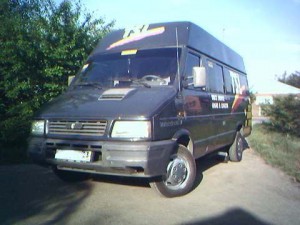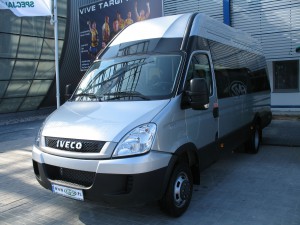Iveco Daily
The Iveco Daily is a large light commercial vehicle produced by Iveco since 1978; it was also sold as the Fiat Daily by Fiat until 1983. Unlike the more car-like unibody Fiat Ducato, the Daily uses a separate ladder frame typical of heavier commercial vehicles.
First generation (1978–1990)
 The first series Daily was offered with two models, the 35 and the 50 (
The first series Daily was offered with two models, the 35 and the 50 (
3.5 and 5.0 tons). The larger
one (Daily 50) had load capacity up to 17 m³. In 1985, a turbodiesel version named “TurboDaily” was introduced. An Alfa Romeo badge engineered version was sold as the Alfa Romeo AR8, similarly to the Fiat Ducato based AR6.
Engines
2.5l diesel 72 hp@4200rpm, 141 Nm a 2400 rpm
2.5l turbodiesel 95 hp@4100rpm, 217 Nm a 2300 rpm
2.5l diesel I.D. 75 hp@4200rpm, 160 Nm a 2200 rpm (only in Zastava Rival)
Second generation (1990–2000)
The second generation Daily was introduced in 1990, with a totally revised cab and improvements
on the Sofim engine (at that time, with a 2.5 L capacity). Following the entry of Ford’s commercial
operation into Iveco,in 1986, The Daily 3.5 ton was soon removed from the UK market as it was now
direct competition with Ford’s Transit, the Daily stayed on in the UK at rated
above 4.0 ton, and now sold as Iveco-Ford Truck. The Daily has no other connection with the Transit.
The second generation was facelifted in 1996; it differs only slightly exterior-wise, but the engine was now
available in 2.8-litre capacity 76 KW (103 hp). The 59-12 (chassis cabs and panel vans) and 59-13 (minibus) models were launched (GVW 6.4 tons). All-wheel-drive variants were also made available.
Engines
2.5l diesel 75 hp@4200rpm
2.5l turbodiesel 103 hp@3800rpm
2.5l tdi 115 hp@3800rpm
2.8l diesel 85 hp
2.8l turbodiesel 103 hp@3600rpm
2.8l tdi 118 hp@3600rpm
Third generation (2000–2006)
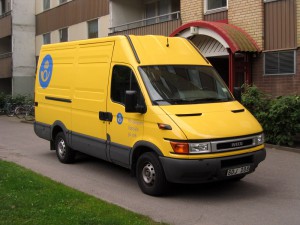 With third series the Daily got new light groups (wider and lower). The Turbodaily name was dropped as all turbodiesels came with Unijet technology (common rail). Two new versions were released: “Agile”, with automatic gearshift, and “CNG”, a natural gas version. Also two new load classes were introduced: Daily 65 and Daily 28 (6.5 tons and 2.8 tons). The Iveco Daily was made “Van of the Year” for the year 2000.
With third series the Daily got new light groups (wider and lower). The Turbodaily name was dropped as all turbodiesels came with Unijet technology (common rail). Two new versions were released: “Agile”, with automatic gearshift, and “CNG”, a natural gas version. Also two new load classes were introduced: Daily 65 and Daily 28 (6.5 tons and 2.8 tons). The Iveco Daily was made “Van of the Year” for the year 2000.
Engines
Originally there were model with three engine options, all of type 8140 of 2.8 liters. A variant was a suction diesel with 66 kW (90 hp), but they rarely sold. Another had turbocharger, intercooler and 78 kW (106 hp). The last variant gave 92 kW (125 hp) and had common rail injection. Shortly after receiving the largest engine variable geometry turbocharger and an output of 107 kW (146 hp).In 2003 came F1A engine with 2.3 litre stroke volume and second-generation common rail injection with 74 kW (101 hp) and 88 kW (120 hp), and in 2004 came the new F1C engine of 3.0 liters, based on F1A with timing chain and 100 kW (136 hp) or 122 kW (166 hp). At this time, the old 8140-engine was completely replaced.
Transmissions
The motors up to 88 kW (120 hp) had five-speed gearbox, while the more powerful engines also available with a six-speed gearbox. The model could also be obtained with electronic / hydraulic controlled manual gearbox, called Agile.
Fourth generation (2006–2011)
The fourth generation was designed by Giugiaro and arrived to markets in the middle of 2006. It’s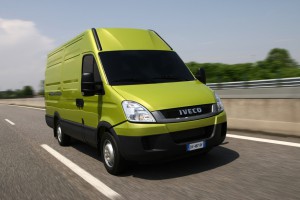
available as: Van, cabin cruiser, Combi, Minibus, Agile, and CNG. The minibus is also commercialized with the Irisbus brand. Certain models with clean engines have been sold as the “Iveco EcoDaily” in some European markets.
For the first time since the year 2000, an all-wheel-drive version of the Daily is available starting from 2007. This is developed in co-operation with the company SCAM and is available as single cab and double cab with the wheelbases 3,050 mm (120 in) and 3,400 mm (130 in) and double cab with wheelbase of 3,400 mm (130 in). Permissible total weight in two versions: 3,500 kg (7,700 lb) or 5,500 kg (12,100 lb).
Engines
2.3 HPI 96 PS (71 kW; 95 hp) and 116 PS (85 kW; 114 hp)
2.3 HPT 90 PS (66 kW; 89 hp)
3.0 HPI 146 PS (107 kW; 144 hp)
3.0 HPT 176 PS (129 kW; 174 hp)
3.0 CNG 136 PS (100 kW; 134 hp)
Fifth generation (2011–2014) “Superman”
The fifth generation was introduced 29 June 2011 and came into the market at the beginning of September 2011.
Engines
Euro 5
2,3 l 78 kW (106 PS)/270 Nm
2,3 l 93 kW (126 PS)/320 Nm
2,3 l 107 kW (146 PS)/350 Nm
3,0 l 107 kW (146 PS)/350 Nm
3,0 l 126 kW (170 PS)/400 Nm
3,0 l 150 kW (205 PS)/470 NmEEV
3,0 l 107 kW (146 PS)/370 Nm
3,0 l 126 kW (170 PS)/400 Nm
3,0 l CNG 100 kW (136 PS)/350 Nm
Sixth generation (2014–)
The sixth generation was introduced in July 2014.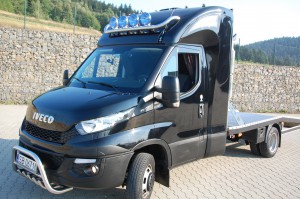
Engines
Euro 5
2,3 l 78 kW (106 PS)/270 Nm
2,3 l 93 kW (126 PS)/320 Nm
2,3 l 107 kW (146 PS)/350 Nm
3,0 l 107 kW (146 PS)/350 Nm
3,0 l 126 kW (170 PS)/400 Nm
3,0 l 150 kW (205 PS)/470 NmEuro 6
3,0 l 107 kW (146 PS)/370 Nm
3,0 l 126 kW (170 PS)/400 Nm
3,0 l CNG 100 kW (136 PS)/350 Nm

